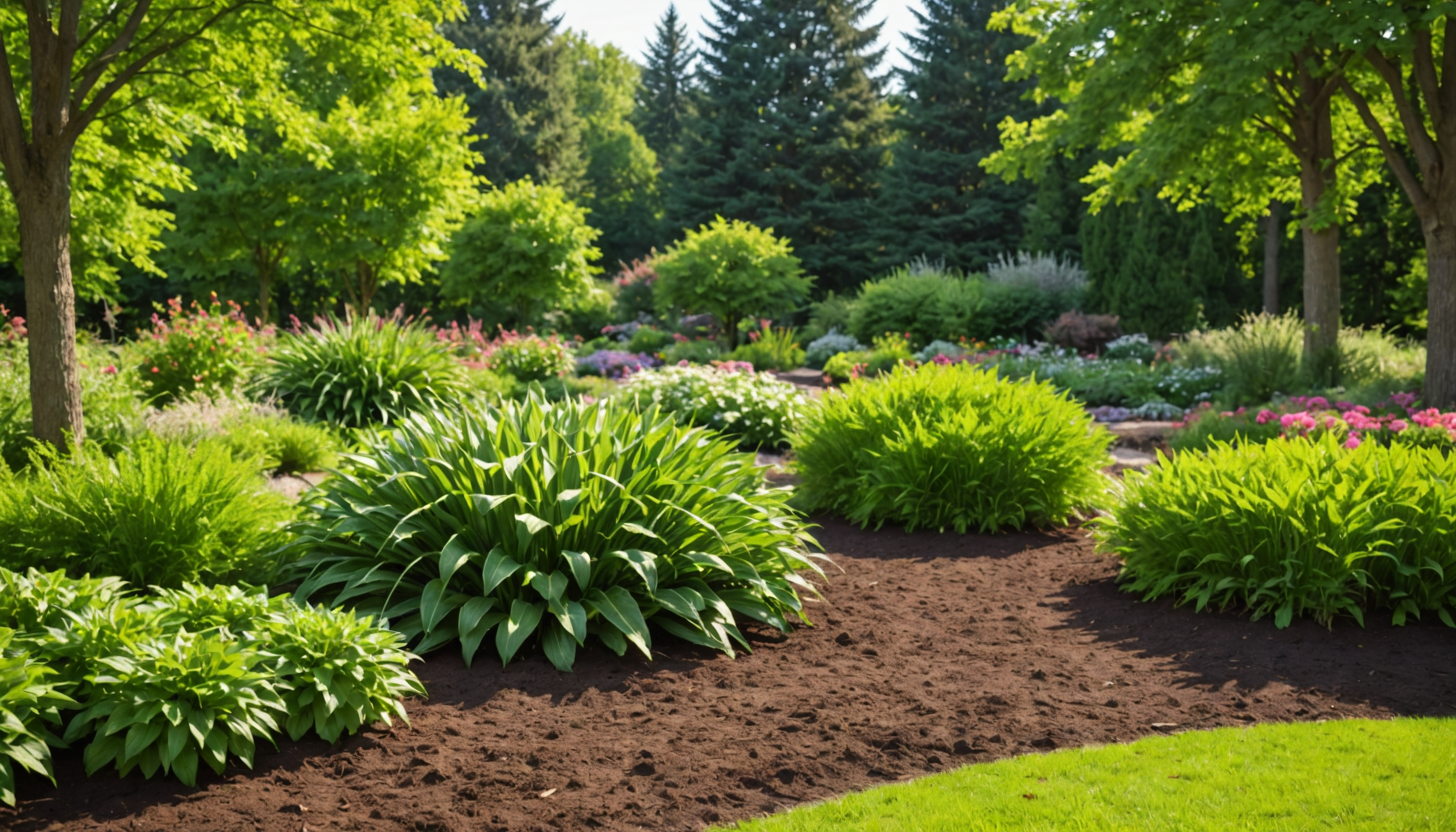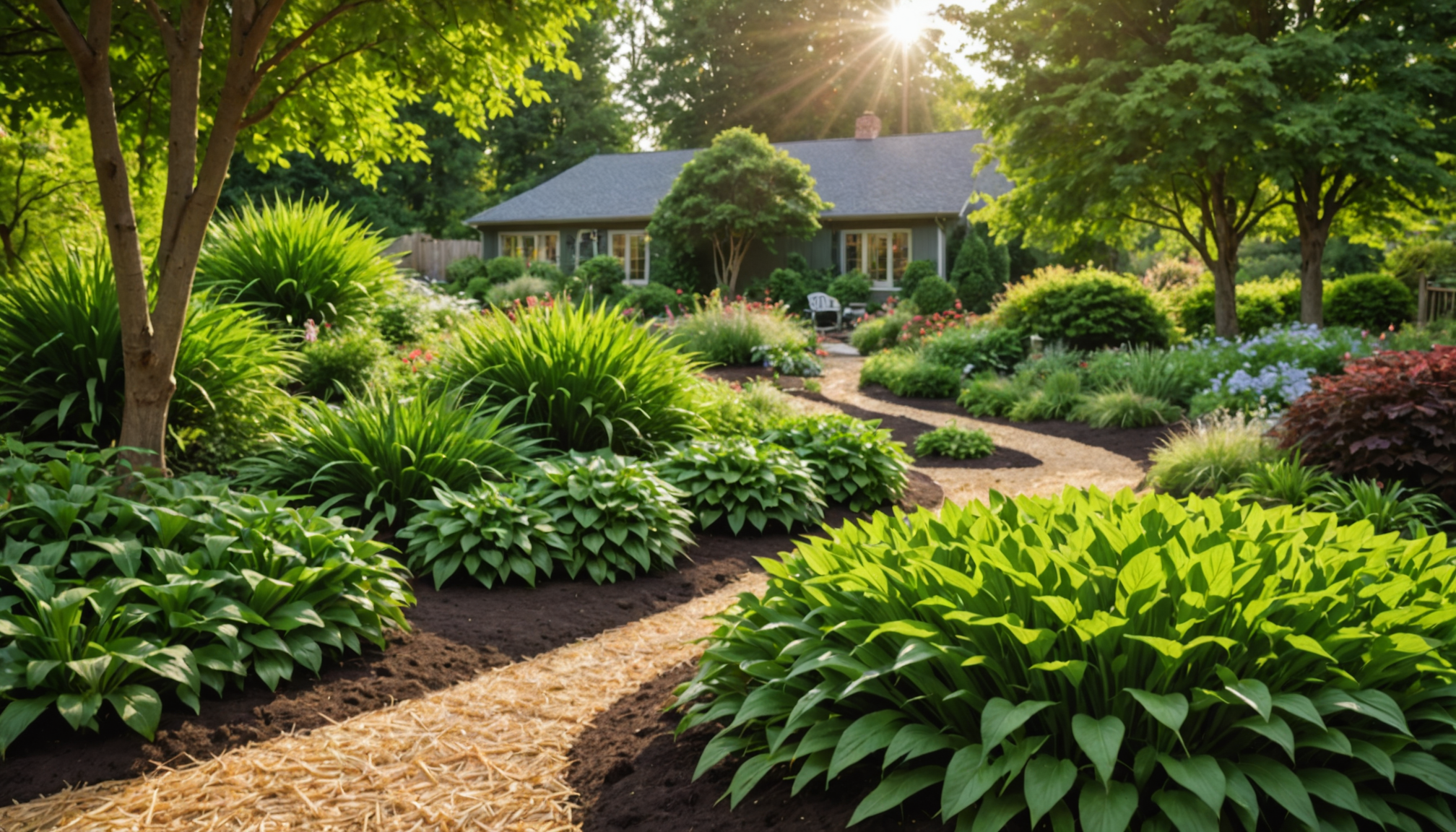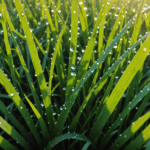Mulching is an essential strategy in the realm of organic gardening, offering a practical and effective way to suppress weeds without resorting to synthetic chemicals. By covering the soil with a protective layer, mulch not only inhibits weed growth but also enriches the garden ecosystem. Understanding the various mulching techniques can enhance weed control efforts significantly, making it a cornerstone practice for anyone committed to eco-friendly gardening.
One of the primary benefits of mulching is its ability to block sunlight, which weeds need to germinate and grow. By creating a physical barrier, mulches such as straw, wood chips, or shredded leaves prevent weed seeds from sprouting. This not only reduces the prevalence of weeds but also saves time and effort dedicated to other maintenance tips throughout the growing season.
There are several types of organic mulches, each offering unique advantages based on the needs of your garden:
- Straw: Ideal for vegetable gardens, straw is light and easy to spread. It decomposes relatively quickly, adding organic matter to the soil.
- Wood Chips: Best used around trees and shrubs, wood chips break down slowly, providing long-term coverage and nutrient release.
- Grass Clippings: A readily available option, grass clippings are rich in nitrogen but should be applied in thin layers to prevent matting.
- Shredded Leaves: As they decompose, shredded leaves provide valuable nutrients and enhance soil structure.
In addition to choosing the right type of mulch, the application technique is crucial for effective weed control. A layer of mulch should be applied to a thickness of two to four inches, ensuring complete coverage for optimal results. Apply mulch evenly around plants, taking care not to pile it against stems or trunks, which can lead to moisture retention and rot.
Here is a comparison of the different types of mulch and their characteristics:
| Mulch Type | Best Use | Decomposition Rate | Additional Benefits |
| Straw | Vegetable Gardens | Medium | Enhances Soil Health |
| Wood Chips | Trees and Shrubs | Slow | Long-lasting Coverage |
| Grass Clippings | Lawns and Yards | Fast | High Nitrogen Content |
| Shredded Leaves | Flower Beds | Medium | Improves Soil Fertility |
Mulching serves as an integral component of sustainable and organic gardening practices. By carefully selecting and applying the appropriate type of mulch, gardeners can effectively suppress weeds while promoting a vibrant, healthy growing environment. It’s a simple yet powerful technique that aligns with natural gardening principles, offering long-term benefits both for the gardener and the ecosystem at large.
Companion planting strategies
Companion planting is an age-old technique in organic gardening that leverages the synergy between different plants to enhance growth, improve pest resistance, and crucially, suppress weeds. By strategically arranging certain plants together, you can naturally manage weed control and cultivate a healthier garden environment. Below is a guide on how to implement companion planting strategies effectively in your garden.
1. Identify Compatible Plant Pairs:
– Research plant compatibility to ensure your chosen pairs or groups can thrive together. For example, tomatoes and basil make an excellent pair as basil can repel pests that might otherwise harm tomatoes.
– Consider plant height and growth habits. Use taller plants to provide shade for shade-loving varieties, inhibiting the sunlight required for weed seed germination.
2. Use Dense Planting Techniques:
– Space plants closely to minimize open soil where weeds can establish. This method works well with fast-growing ground covers like nasturtiums, which crowd out weeds efficiently.
– Plan your garden layout to optimize plant density without sacrificing individual plant health, ensuring every inch of soil serves a purpose.
3. Select Weed-Suppressing Plants:
– Opt for allelopathic plants, which release chemicals that inhibit weed growth. These include walnuts and sunflowers; however, be mindful as they might affect certain garden plants too.
– Incorporate spreading plants like pumpkins and squash in your garden. Their large leaves create a natural canopy, suffocating weeds by blocking sunlight.
4. Employ a Staggered Planting Approach:
– Rotate plants with seasonal or growth cycles to ensure the soil remains covered year-round. After harvesting a quick-growing spring crop, sow a summer crop to fill the space.
– Utilize fast-maturing plants alongside slower ones. This strategy ensures that slower plants have ample time to develop while fast-growing ones shield the ground.
5. Integrate Perennial Companions:
– Include perennials like rhubarb or asparagus around annual crops as they consistently occupy space and create a robust barrier against weeds.
– Interplant perennials that benefit annuals, such as planting strawberries with asparagus, where the asparagus shades and controls weeds for the strawberries.
6. Monitor and Adjust Plant Combinations:
– Regularly observe plant interactions to ensure they’re mutually beneficial. If a combination isn’t thriving, be flexible and adjust your pairings based on observed plant behavior and garden needs.
– Document successful combinations to replicate or modify the following season for improved weed control and garden efficiency.
By integrating these strategies into your gardening practice, you can effectively manage weeds naturally while promoting a symbiotic environment in your garden. As you embrace these companion planting tips, you’ll enhance the overall vitality and productivity of your garden, reducing the time and resources spent on maintenance.
The benefits of manual weeding
Manual weeding is often viewed as a traditional, time-consuming chore, yet it stands out as one of the most effective and environmentally friendly strategies for keeping your garden free of unwanted intruders. By removing weeds by hand, gardeners engage in a form of precision weed control that not only addresses the root causes of weed proliferation but also enhances their understanding of the garden ecosystem. The act of manual weeding comes with various benefits that support the principles of organic gardening and sustainable practice.
One of the greatest advantages of manual weeding is the immediate removal of weeds from your garden. Unlike other methods, which might take time to yield results, pulling weeds by hand assures that these unwanted plants are effectively removed, including their roots. This direct action significantly reduces the likelihood of weeds growing back quickly. Ultimately, this approach saves time and reduces the need for repetitive maintenance tasks throughout the growing season.
Another compelling benefit of manual weeding is the potential to protect and preserve the health of your plants and soil. By physically removing weeds, you avoid the use of chemical solutions that can sometimes lead to unintended harm to beneficial microorganisms in the soil. Manual weeding supports a healthier ecosystem by ensuring that your soil remains intact and full of organic matter, which is crucial for plant health and productivity.
Furthermore, manual weeding allows you to familiarize yourself with your garden’s unique needs and rhythms. As you engage with your plants up close, you develop a keen observation of plant health, soil conditions, and the overall balance of your garden environment. This deeper connection enables you to spot other potential issues early, such as diseases or pests, leading to more informed decisions about organic gardening practices.
Moreover, weeding by hand provides an opportunity to implement maintenance tips more effectively, like adjusting plant spacing or identifying areas that might benefit from additional mulching or companion planting strategies. This hands-on involvement can lead to significant insights into optimizing your garden layout to naturally suppress weed growth.
Finally, manual weeding is a sustainable approach that aligns seamlessly with the values of eco-conscious gardening. By choosing manual weeding over mechanical or chemical alternatives, gardeners contribute to environmental conservation efforts while fostering a garden that thrives on natural principles. With manual weeding, not only do you engage in thorough weed control, but you also celebrate and honor the timeless art of gardening in harmony with nature.
Utilizing natural weed barriers
Incorporating natural weed barriers is a powerful way to maintain your garden’s health while adhering to principles of organic gardening. By using physical obstacles that exist naturally or with minimal modification, you can effectively impede the growth of unwanted plants without resorting to synthetic chemicals. This method offers a sustainable approach to weed control, fitting seamlessly into a garden ecosystem that thrives on organic practices.
One of the most effective natural barriers is the use of landscape fabric or burlap. These materials can be laid over the soil surface, blocking light and preventing weed seeds from germinating. When placed strategically around plants, these breathable fabrics allow water and nutrients to reach your plants while suffocating potential weeds. Over time, as these barriers degrade, they add organic matter back into the soil, enhancing its fertility and structure.
Another practical option is to incorporate dense living barriers. Utilizing ground covers like clover, creeping thyme, or vinca is a fantastic way to cover bare soil, which might otherwise be an invitation for weeds. These dense plantings create a canopy that not only suppresses weeds by shading the soil but also contributes to soil health through nitrogen fixation and other beneficial interactions. This process is a testament to the synergy within organic gardening, where each element serves multiple purposes.
Creating physical barriers using natural materials found around your home is also an effective strategy. Consider using stones, logs, or bricks to define garden borders and pathways. These materials obstruct weed growth by occupying space that would otherwise host unwanted plants. Furthermore, hardscaping elements like these can help in water conservation, directing moisture exactly where it’s needed and further contributing to the holistic balance of your garden’s ecosystem.
Additionally, incorporating aquatic barriers such as ponds or water features can significantly reduce weed proliferation in adjacent areas. The moisture from these features supports beneficial plants that can outcompete weeds through a natural balance of species interaction. This demonstrates how water elements play a crucial role in organic weed management.
Employing straw bales or logs to create a barrier around your garden beds is another effective technique. These barriers not only prevent weeds from creeping into garden beds but also provide habitat for beneficial insects and decomposers that enhance soil fertility over time. Such uses of natural materials underscore the maintenance tips that focus on adaptability and resourcefulness.
Ultimately, utilizing natural weed barriers is an empowering practice that aligns perfectly with eco-friendly and sustainable gardening principles. It allows you to craft a garden environment that is as beautiful as it is resilient, ensuring that your garden thrives through thoughtfully implemented weed control strategies that reflect a deep respect for the natural world. Embracing these techniques can transform your gardening experience, fostering a lush, vigorous landscape maintained through innovation and common sense.
Soil health and its impact on weeds
A thriving garden starts from the ground up, with healthy soil playing a crucial role in suppressing weeds and supporting plant growth. Understanding the intricate relationship between soil health and weed control is essential for any gardener aiming to maintain a robust and productive garden using organic gardening techniques.
Healthy soil is teeming with life, including beneficial microorganisms and insects that form a vibrant ecosystem. These organisms enhance nutrient availability and improve soil structure, which can make it more difficult for weeds to establish. When your soil is thriving, it tends to support stronger, more competitive plants that can naturally outcompete many types of weeds. Regularly enriching your soil with organic matter such as compost, aged manure, or well-decomposed mulch boosts its fertility, leading to a dynamic balance where desirable plants flourish.
In addition to nutrient enrichment, maintaining optimal soil pH is another effective weed management strategy. Most garden plants thrive in slightly acidic to neutral soil (pH 6.0-7.0). If your soil is too acidic or too alkaline, it can create an environment where certain weeds thrive over your desired plants. Periodically testing your soil and adjusting its pH with lime or sulfur, based on its current state, ensures it remains conducive to your plants’ needs while discouraging weeds.
Good soil health promotes effective drainage, preventing standing water that can be a breeding ground for weeds. Poor drainage often promotes shallow-rooted weeds that thrive in such conditions, overtaking more deeply rooted garden plants. Improving soil texture with organic matter enhances its ability to retain just the right amount of moisture without becoming waterlogged, reducing the chances of weed infestation.
An often-overlooked aspect of soil health is its texture and compaction level. Compacted soil can hinder root growth and undermines plants’ ability to access nutrients and water. In contrast, loose, well-aerated soil supports vigorous root systems which can help tame aggressive weeds. Regular soil maintenance tips, like gentle tilling or double digging, improve aeration and root penetration, facilitating optimal plant growth.
Additionally, fostering biodiversity within the soil itself can be a powerful form of natural weed control. Diverse microorganisms and fungi often establish symbiotic relationships with plant roots, enhancing nutrient uptake and bolstering plants’ ability to suppress weeds through competition. By introducing mycorrhizal fungi, and incorporating varied organic materials, you can foster this biodiversity and create a resilient garden ecosystem.
In summary, nurturing your soil’s health is not just a one-time effort but an ongoing commitment that pays dividends in the form of natural weed suppression and more robust plant growth. Embracing soil-friendly practices and continually tending to your garden’s foundation ensures you are well-positioned to handle weeds organically, paving the way for a flourishing, low-maintenance garden. By prioritizing soil health, you’re not just growing plants; you’re cultivating a living, breathing ecosystem that sustains and nourishes itself, reducing the reliance on external interventions and leading to a more sustainable gardening experience.











